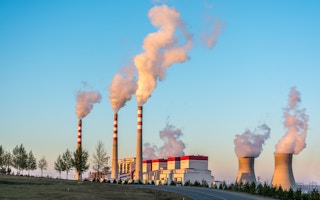China risks cutting emissions too slowly if it fails to reconcile climate goals with other national priorities in the coming years, and only an economic collapse would then see it hit climate targets, a leading energy researcher at the National University of Singapore has said.
To continue reading, subscribe to Eco‑Business.
There's something for everyone. We offer a range of subscription plans.
- Access our stories and receive our Insights Weekly newsletter with the free EB Member plan.
- Unlock unlimited access to our content and archive with EB Circle.
- Publish your content with EB Premium.
Speaking at a virtual conference on Wednesday (24 Feb), Philip Andrews-Speed, senior principal fellow at NUS’s Energy Studies Institute, said coordinating different government objectives will be a major challenge facing China this decade, requiring tough decisions to manage policy trade-offs.
There will be “winners and losers” as countries overhaul their economies to slash emissions, and governments need to muster the political will to resolve policy tensions set to arise as they begin to change course, he told the audience.
However, there have been no signs that China’s 14th five-year plan, a top-level overarching policy blueprint due to be released in March, will thoroughly address policy conflicts threatening to hamstring climate action in the country.
While tensions may be evident from the text of the document, how the impacts of the needed interventions will be cushioned has yet to be revealed. This puts more expectations on the five-year plan for energy, which is expected to come out later in 2021 or early next year.
“If China keeps economic growth going at 3 to 4 per cent, there is still a lot to do to resolve potential tensions in the next five or 10 years. If the government doesn’t do it over that period, the [low-carbon transition] will be much slower,” said Andrews-Speed at the event, themed Policy Tensions Facing China as it Develops its Five-Year Plan for Energy.
“
Carbon neutrality may not be at the top of [China’s] agenda. And even if it is today, it may not be tomorrow.
Philip Andrews-Speed, senior principal fellow, Energy Studies Institute, National University of Singapore
Since President Xi Jinping unveiled China’s ambition to become carbon neutral by 2060 and peak emissions this decade last September, several studies have explored the policies and technologies that would enable the country—the world’s largest carbon emitter—to meet this goal.
But these papers have largely failed to acknowledge the Chinese government’s many other pressing policy priorities, such as macroeconomic, industrial, social, and security objectives, said Andrews-Speed.
“Carbon neutrality may not be at the top of [China’s] agenda. And even if it is today, it may not be tomorrow,” he said.
There are several elements of China’s present energy policy, for instance, that risk undermining a more progressive environmental agenda.
As the country grapples with the intermittency challenges posed by renewable energy sources such as wind and solar, the push for greater self-sufficiency in energy supply saw it ease curbs on coal power plant development in 2019.
This led local authorities to approve the construction of 36.9 gigawatts (GW) of coal-fired capacity last year, three times more than in 2019, bringing the total coal power capacity under development to 247 GW, enough to supply all of Germany’s electricity. China also continues pursuing an expansion of its petrochemical industry.
Then there is the continued dominance of China’s inert state-owned enterprises in the energy sector, which stands in the way of the technology innovation needed to bring down emissions.
China may have been putting pressure on state-owned firms to become commercially viable, promoting market forces that could see disruptive low-carbon technologies gain ground. But this has raised questions about whether these enterprises can hold on to the current number of employees. Social stability remains a central political imperative, and mass unemployment is to be avoided where possible.
Nowhere does China’s social policy clash with its climate commitments as it does over the fate of its coal industry, which employs tens of millions of people in mines alone. Especially as the country recovers from Covid-19, it may be reluctant to leave incumbent fossil fuel industries behind.
Meanwhile, China’s social policy is in conflict with its goal to switch from coal to gas for heating. While deemed a cleaner source of heat and power compared to coal, gas is a significantly costlier fuel, and recent harsh winter months have forced poorer households in China’s northern provinces to freeze to cut back on heating costs.
The upcoming five-year plan aims to double China’s GDP by 2035, implying an average annual growth rate of about 4.4 per cent from 2021 to 2035. While in the interest of social stability, decoupling such rapid growth from emissions may prove difficult.
Andrews-Speed noted it was still possible that such tensions might be resolved by the new development blueprints, but past practice suggested that this would not be the case. China is at present responsible for about 28 per cent of global carbon dioxide emissions.










